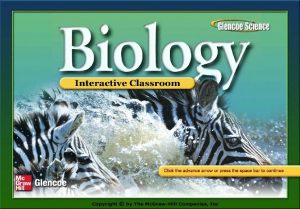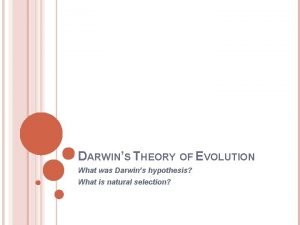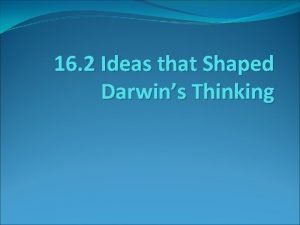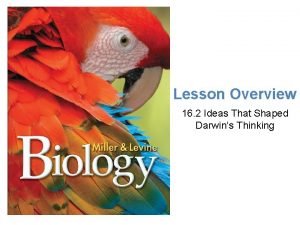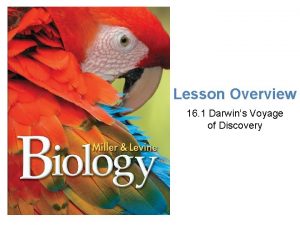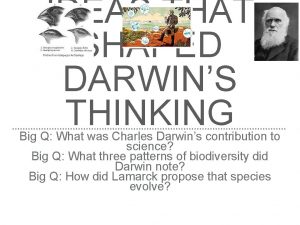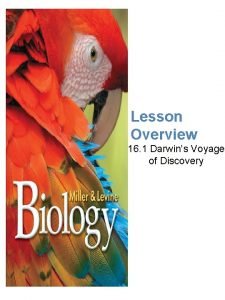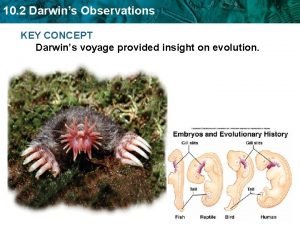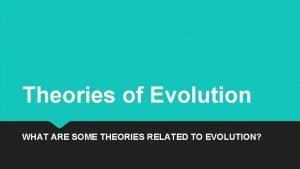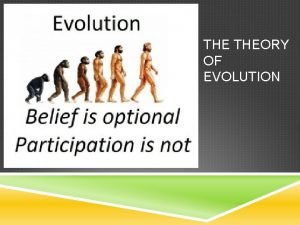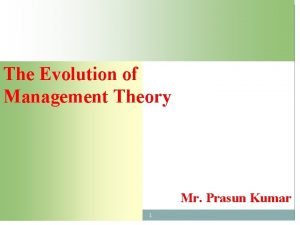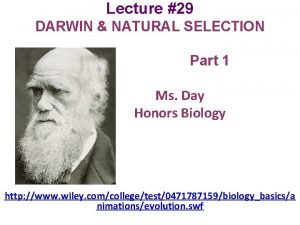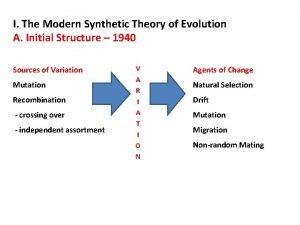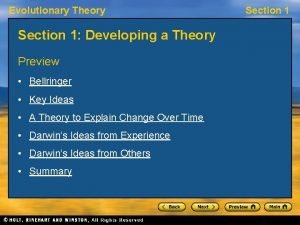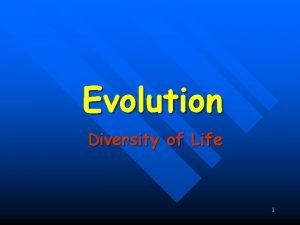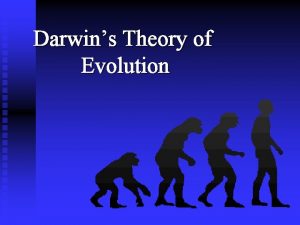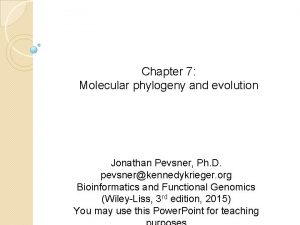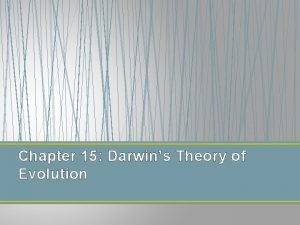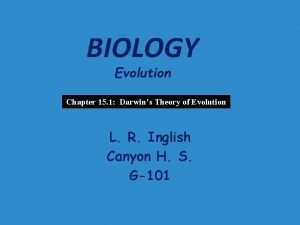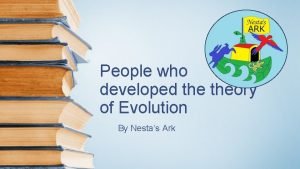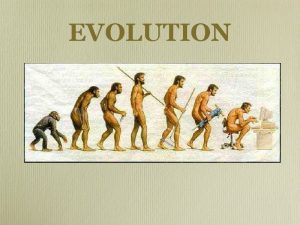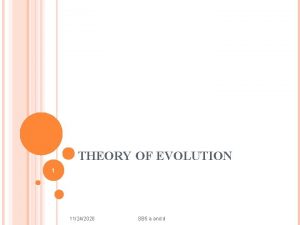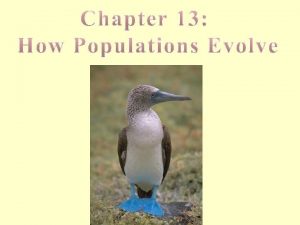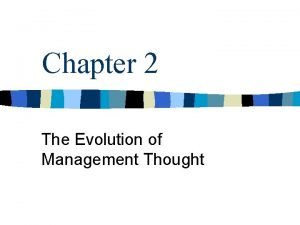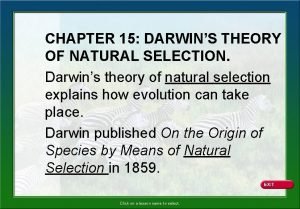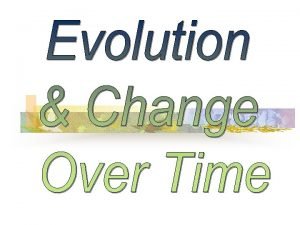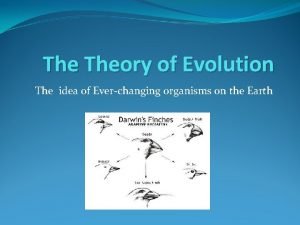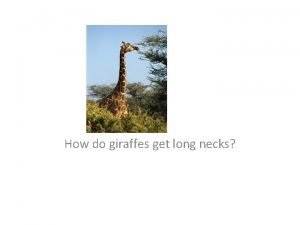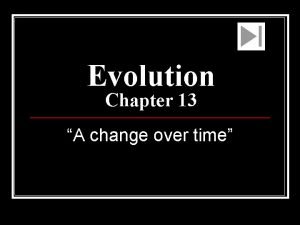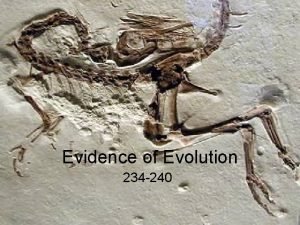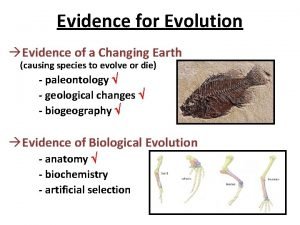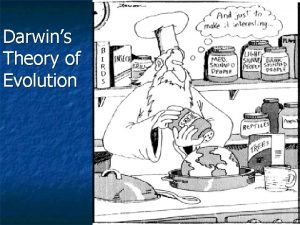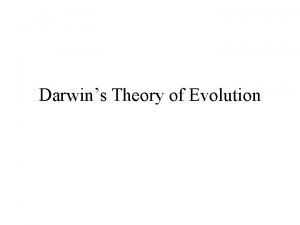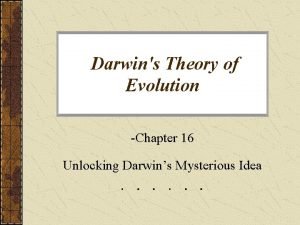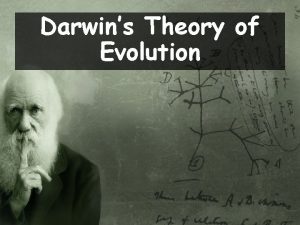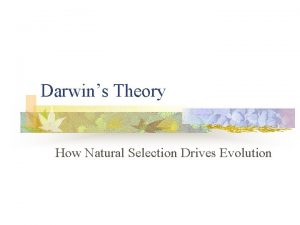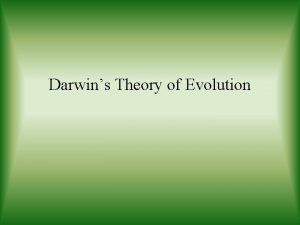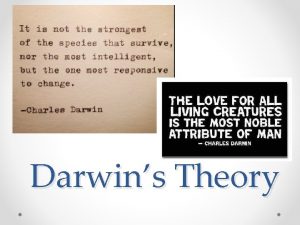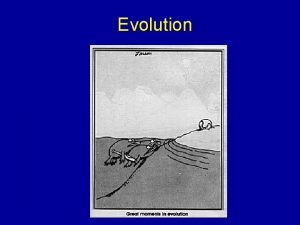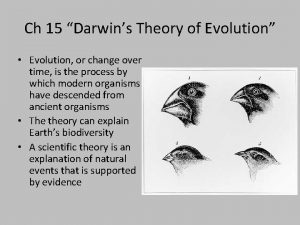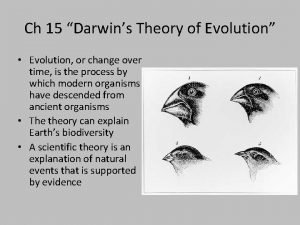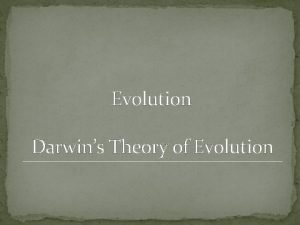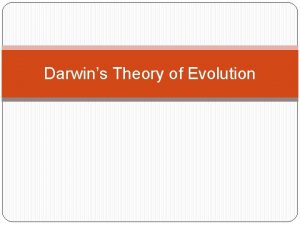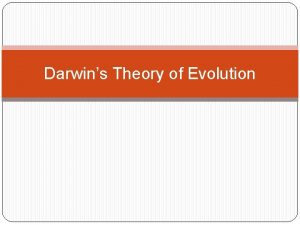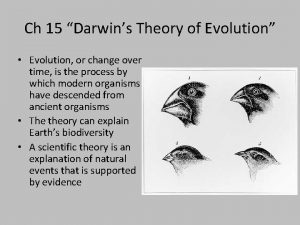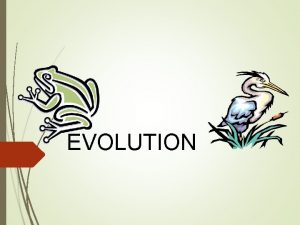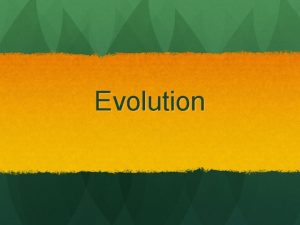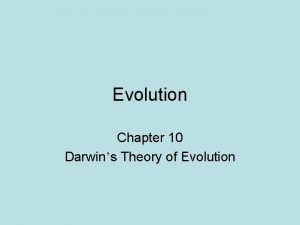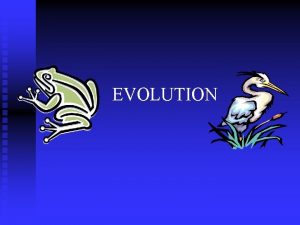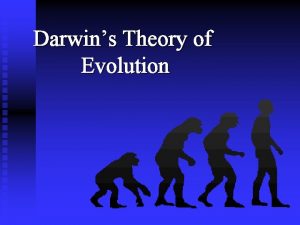CH 15 EVOLUTION Ch 15 1 DARWINS THEORY







































- Slides: 39

CH. 15 EVOLUTION

� Ch. 15. 1 – DARWIN’S THEORY OF EVOLUTION BY NATURAL SELECTION � MAIN IDEA – Charles Darwin developed a theory of evolution based on natural selection. � QUESTION: What do you think you can look at to see how species change over time? � Where did Charles Darwin do most of his studies in regard to figuring out evolution?

� Developing the Theory of Evolution � In 1831 when Charles _______ began his voyage most people believed that the world was _______ yrs. old & animal & plants did _____ change. � During Charles Darwin voyage on the HMS ____, which lasted 5 years, he collected biological (plants & animals) and geological specimens (fossils). � Darwin read a book by Charles Lyell, which proposed that the Earth was _________ of years old. � This book influenced Darwin’s thinking as he observed fossils of marine life at _____ elevations, giant

Darwin in the Galapagos Islands � ___________________ are located off the west coast of S. America. � Darwin studied the mockingbirds, _________ & _________ from the ________ islands � Discovered that he could recognize what island the tortoises came from by their __________. � After returning to England Darwin discovered that the finches of the Galapagos were found ____ where else, but they closely resembled the species from mainland S. America. �Should ______ have resembled each other because of ___________ �

� Tortoises and Finches of the Galapagos Islands csmonitor. com digitaljournal. com

DARWIN CONTINUED HIS STUDIES � Darwin hypothesized that ____ species could appear gradually through small changes in ancestral species. � Darwin looked to breeders of pigeons to help understand these changes. � _____________ or selective breeding is the process of directed breeding to produce offspring with the ___________________. � Learned that breeders do select and breed the pigeons for the _____ exaggerated certain traits. �EX: larger tails �

� NATURAL SELECTION � Natural selection says that some ___________ in the struggle for existence would be ___________ equipped for survival than others. The competitors ______ equipped ______. �Thomas ______ influenced Darwin’s thinking on natural selection. Malthus’ essay suggested that the human population if left unchecked would outgrow its food supply, leading to a _________ struggle for

Natural Selection – Cont. � Darwin’s theory of evolution by natural selection has 4 principles: � 1. Individuals in a population show differences or ____________________. � 2. Variations can be _____________. � 3. Organisms have _______ offspring than can _____________ on available resources. � 4. Variations that __________ reproductive success will have a __________ chance of being passed on than those that do not increase reproductive success. �

� The Origin of Species About 1840 Darwin formulated his theory of evolution and he began writing his book that explained natural selection. � Darwin compiled evidence to support his theory of evolution for years. � In 1858 Alfred _____________ proposed a theory almost identical to Darwin’s theory. � Both men presented their ideas on evolution and a year later Darwin published his book, “On the ____________________ by Means of Natural Selection. ” � Evolution is defined as the cumulative ________ in groups of organisms through __________. �

� � � � � QUICK QUIZ 1. Darwin referred to the process of promoting certain traits by breeding members with those traits as______. A. Natural selection B. Artificial selection C. Evolution D. Ancestral breeding 2. What theory accounts for why populations can be modified over time? A. Natural selection B. Artificial selection C. Ancestral modification D. Fossil theory 3. A. B. C. D. Which statement is true regarding evolution? It describes changes over many generations. It is the same as natural selection. It only involves artificial selection. It occurs within a single generation. 4. A. B. C. D. What are 2 main components of natural selection? Vestigial structures and camouflage Artificial Selection and selective breeding Variation and inheritance Mimicry and artificial selection

�Section 15. 2 – EVIDENCE OF EVOLUTION �MAIN IDEA – Multiple lines of evidence support theory of evolution. �QUESTION: What evidence supports theory of evolution by natural selection?

� � SUPPORT FOR EVOLUTION A __________ provides an explanation for a natural phenomenon based on ________. Theories explains available data and suggest further areas for experimentation. Theory of evolution states that all organisms on Earth have __________ from a _________ ancestor. The ________________ provides a record of species that lived long ago and supply some of the most significant ___________ of evolutionary change. � Shows how ancient species are ___________ to current species. � Shows that _________ species have remained _____________ for _________ of years. � Fossil record is an important source of information for determining the ____________ of organisms and patterns of

� EXAMPLE OF FOSSIL RECORD

� SUPPORT FOR EVOLUTION – CONT. � Two major classes of traits when looking at transitional fossils are: �___________ traits – newly evolved features, like feathers, which do ______ appear in the fossils of common ancestors �_________ traits – are more primitive features, like teeth and tails, which _____ appear in the ancestral form. �__________ fossils provide detailed patterns of evolutionary __________ for the ancestors of

� COMPARATIVE ANATOMY � ___________________ are anatomically _______ structures that are ________ from a ______ ancestor. �Evolution predicts that an organism’s body parts are more likely to be _________ of ancestral body parts than to be entirely _______ features.

� VESTIGIAL STRUCTURES � _________ structures are structures that are ___________ forms of functional structure in other organisms. � Evolutional theory predicts that features of ancestors that _____ longer have a function for that species will become _________ over time until they are _________. �Ex: snake pelvis – pelvis but no legs attached �Ex: human appendix – important for digestion in many mammals but only limited

� ANALOGOUS STRUCTURES � ________ structures can be used for the _______ purpose and can be superficially ________ in construction but are ______ inherited from a common ancestor. �Ex: wings of an eagle and wings of a beetle have same function, but are constructed in different ways and from different materials � Analogous structures do ____ indicate _______ evolutionary relationships, they do show that functionally similar features can evolve ______________

� COMPARATIVE EMBRYOLOGY � ____________ embryos provide more glimpses into evolutionary relationships. � __________ is an early prebirth stage of an organism’s development. � Vertebrate embryos exhibit ________________________ during certain phases of development but become __________________ structures in the adult form. �Demonstrates that the embryos of vertebrates evolved from a

� COMPARATIVE EMBRYOLOGY

ADAPTATION � ___________ is a trait shaped by natural selection that _______________ an organism’s ______________ success. � � � Ex: either physical or behavioral ___________ is a measure of the relative contribution that an individual ___________ makes to the _____________ generation. � Measured as the number of reproductively viable ________________ that an organism produces in the next generation. � Better an organism is adapted to its environment, the ___________ its chances of ______ and ________________ success. � EX: environments _________ on the different ________________ so

� ______________ is the ability of an organism to ___________ in with their ___________________ __. �Allows organisms to become almost __________ to _________. �______ survival & ability to reproduce � __________ is where one species has evolved to _________ another species.

� � � � QUICK QUIZ – SECTION 15. 2 1. Recently evolved traits that do not appear in ancestral fossils are called ____. A. Homologous traits B. Ancestral traits C. Primitive traits D. Derived traits 2. A morphological adaptation in which one species resembles another is called _____. A. Mimicry B. Camouflage C. Vestigial adaptation D. Fitness QUICK QUIZ CONTINUED 3. Which of these is an example of analogous structures? A. Hawk wings and fish fins B. Hawk and insect wings C. Horse legs and insect wings D. Horse legs and elephant trunks.

�Section 15. 3 – SHAPING EVOLUTIONARY THEORY �MAIN IDEA – The theory of evolution continues to be refined as scientists learn new information. �QUESTION: How would an albino of a species that is normally green and lives among leaves be less fit?

� � Mechanisms of Evolution Scientists Hardy & Weinberg showed mathematically that evolution will _______ occur in a population unless allelic frequencies are acted upon by ___________ that cause ______________________ is when allelic frequencies remain _____________ in a population. For a population to stay in genetic equilibrium 5 conditions must be meet: � 1. there must be ______________ genetic drift � 2. no ________________________ � 3. no ________________________ � 4. mating must be

� _________________ is any change in the allelic frequency in a population that results from _______. �In _________ populations allelic frequency remains relatively ______ from one generation to the next. �In _______ populations the effects of genetic drift becomes more pronounced and the chance of losing an allele becomes

� ______________ can occur when a ___________ sample of a population settles in a location ____________ from the rest of the population. � EX: Amish or Mennonite populations in the US � __________ occurs when a population __________ to a very _____ number and then _________________. � __________ of the rebound population often is genetically __________ to the population at its ______________ level and has reduced diversity. � ___________ has random movement of individuals between populations,

� Nonrandom mating – ____________ is mating completely random in a population, usually will mate with an individual in _____ proximity. � EX: Promotes _____________ � ________________ is a random change in genetic material. � Mutations may cause a ___________ in allele frequency, which violates genetic equilibrium. � Mutations can be harmful, helpful, or no affect � When a mutation gives an organism an _______________, the mutation will be selected ________ and become ______ common in subsequent

�Natural selection acts on an organism’s _______________ and changes allele frequencies. � 3 ways that natural selection alters phenotypes: �____________ selection

� Stabilizing selection �Stabilizing selection is the ______ common form of natural selection �Will _______________ extreme expressions of a trait when the average expression leads to __________________. �Ex: babies born of average weight have best chance of survival

�Directional selection occurs when the ____________ version of a trait is ________ fit for survival. �EX: Galapagos Island finch beak size.

�Disruptive Selection �Disruptive selection is a process that _______ a population into ____ groups. It will __________ individuals with the ________ traits and retain individuals that express the extreme traits at ________ ends of a bell curve.

� Sexual Selection is another type of natural selection based on the frequency of a trait that enables an organism to _______ a _______. �Occurs in populations where male and female organism __________ in appearances. �Usually males are __________ than females and more ________. �EX: peacock – males have the

Reproductive Isolation � 2 types of ___________________: � Prezygotic isolating mechanism �Operate __________ fertilization occurs which prevents ____________ from entering the population’s ___________ �Ex: birds mating songs or dances are different or the time when mating occurs is different � Postzygotic isolating mechanisms �The _________ offspring are ______ �Ex: tiger & lion produce liger, which is sterile �

� _______________ is the process where members of a sexually reproducing population change so much that they can ______ longer produce ______ offspring with members of the original population. � 2 types of speciation: �Allopatric speciation (geographic isolation)– where a physical _______ divides one population into 2 or more populations. Eventually after enough time has passed the populations will _______ longer be able to __________ successfully with one another �Most common form of speciation.

� Sympatric speciation – where a species evolves into a _______ species ________ a physical barrier. �Ex: polyploidy plants �Temporal Isolation – Members of that species will ______ mate together because the _____ that they mate has _______. �Ex: Used to mate in the morning, now mates in evening �Behavioral Isolation – Members of that species will no longer mate together because the _______________ has

Patterns of Evolution � _______________, also called divergent evolution, can occur in a relatively _______ time when one species gives rise to many species in response to the creation of a ________________ or another ecological opportunity. � Adaptive radiation often follows large scale ____________________. �Ex: mammals increased drastically after the extinction of dinosaurs. � ___________ occurs where 2 species living in close relationship with another species affects the evolution of ________ species. Another form of coevolution is where one species can evolve a parasitic dependency on another species. �

� Convergent Evolution � ________________ occurs when __________ species evolve _________ traits even though they live in ________ parts of the world but with similar ecology and ______. � ___________ is a theory which states that evolution proceeds in ____, gradual steps. � ___________ equilibrium is a theory which states that ________ transitions in the _______ record occurs due to rapid spurts of genetic change causing species to diverge

� CONVERGENT EVOLUTION

� QUICK QUIZ: � 1. What occurs when average traits benefit a population rather than extreme traits? � A. Unnatural selection B. Directional selection � C. Disruptive selection D. Stabilizing selection � 2. What has occurred when fertilization produces a hybrid offspring that cannot develop or reproduce? � A. prezygotic isolation B. Postzygotic isolation � C. Non-reproductive isolation � D. Speciation
 Chapter 17 darwin's theory of evolution
Chapter 17 darwin's theory of evolution Chapter 15 section 1 darwins theory of natural selection
Chapter 15 section 1 darwins theory of natural selection Darwin hypothesis
Darwin hypothesis Section 15-2 ideas that shaped darwins thinking
Section 15-2 ideas that shaped darwins thinking Section 15-2 ideas that shaped darwin's thinking
Section 15-2 ideas that shaped darwin's thinking Adaptation
Adaptation Ideas that shaped darwins thinking
Ideas that shaped darwins thinking Lesson 1 darwins voyage of discovery
Lesson 1 darwins voyage of discovery Section 15-2 ideas that shaped answer key
Section 15-2 ideas that shaped answer key Darwin's voyage of discovery
Darwin's voyage of discovery Darwins observations
Darwins observations Lamarck's theory of evolution
Lamarck's theory of evolution Developmental homologies
Developmental homologies Evolution of management theory
Evolution of management theory 3 types of natural selection
3 types of natural selection Modern synthetic theory of evolution notes
Modern synthetic theory of evolution notes Modern evolution theory
Modern evolution theory Lamarck’s theory of evolution.
Lamarck’s theory of evolution. What was lamarck's theory of evolution
What was lamarck's theory of evolution Chapter 15 darwin's theory of evolution
Chapter 15 darwin's theory of evolution Neutral theory of molecular evolution notes
Neutral theory of molecular evolution notes Evolution section 3 shaping evolutionary theory
Evolution section 3 shaping evolutionary theory Chapter 15 darwin's theory of evolution section 15-1
Chapter 15 darwin's theory of evolution section 15-1 Chapter 15 darwin's theory of evolution section 15-1
Chapter 15 darwin's theory of evolution section 15-1 Explain the theory of evolution
Explain the theory of evolution Theory of natural selection
Theory of natural selection Lamarck theory of evolution notes
Lamarck theory of evolution notes Theory of evolution
Theory of evolution Theory of evolution
Theory of evolution Evolution of management
Evolution of management Natural selection
Natural selection What does darwin's theory of evolution suggest?
What does darwin's theory of evolution suggest? Law of natural selection
Law of natural selection Lamarck theory of evolution notes
Lamarck theory of evolution notes Darwin's theory of evolution
Darwin's theory of evolution Theory of evolution
Theory of evolution The theory that evolution occurs slowly but steadily
The theory that evolution occurs slowly but steadily Lamarckian evolution
Lamarckian evolution The theory that evolution occurs slowly but steadily
The theory that evolution occurs slowly but steadily A remarkable turnaround case study
A remarkable turnaround case study

